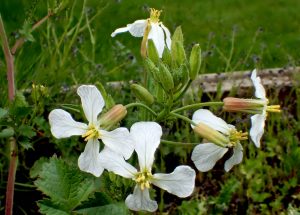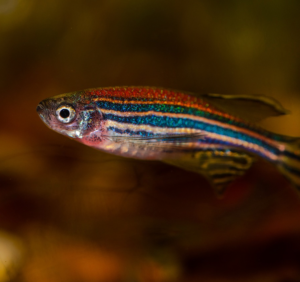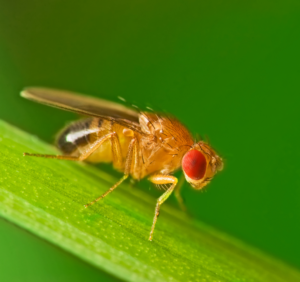Even though domestic plants usually appear radically different from their wild relatives, they are often still able to interbreed. For transgenic crops carrying traits like herbicide resistance, this flexibility could pose a problem if they were to pollinate weedy relatives nearby. In the July issue of GENETICS, Adamczyk-Chauvat et al. examine the extent to which alleles from cultivated oilseed rape introgressed into the genome of wild radish after several generations of cross-pollination. They found that certain regions of the genome were more likely to be passed from domestic to wild plants, suggesting that targeting transgenes into specific genomic locations could limit their putative escape into weeds.
Oilseed rape, also known as rapeseed, is a brilliant yellow flowering plant cultivated around the world for its oil-rich seeds, which are used for animal feed, biodiesel, and edible vegetable oil. Oilseed rape is one of the main transgenic crops worldwide, carrying genes introduced mainly for herbicide resistance. The crop has a very low rate of natural hybridization with wild radish, a weedy relative, but the transfer of herbicide resistance to weeds could pose a major economic problem for farmers.

Wild radish flowers. Photo Brenda Dobbs via Flickr.
The authors grew a population of oilseed rape plants in a natural field environment and pollinated the crops with wild radish. They continued pollinating the hybrid offspring with wild radish for five generations. To trace how the genomes of these two species had merged in the fifth-generation plants, the team chose 307 hybrids with a chromosome number close to the one of wild radish. They identified oilseed rape alleles in each of these hybrids by genotyping a set of markers spanning the genome and found around half the individuals had a detectable oilseed rape allele. However, nearly 70% of markers carried mainly the radish allele—there was a very low probability of introgression (p1=0.003) at those sites.
In contrast, a few markers were frequently introgressed; interestingly, these markers were not found in random locations but were grouped together in specific regions of the genome. The two most highly introgressed markers were located together on one chromosome and adjacent to several other less frequently introgressed markers. They also found that 30% of introgressed markers were located on the ends of chromosomes rather than in the middle.
These patterns likely arise from the differences in genome structure between oilseed rape and wild radish. Though they can hybridize, they have different chromosome numbers. This striking pattern suggests that using a precisely targeted genome editing method like CRISPR to insert transgenes in select genomic regions could be a possible strategy for keeping them confined to the cultivated species, though more work is needed to see how widely applicable this finding might be.
CITATION:
Gene Introgression in Weeds Depends on Initial Gene Location in the Crop: Brassica napus–Raphanus raphanistrum Model
Katarzyna Adamczyk-Chauvat, Sabrina Delaunay, Anne Vannier, Caroline François, Gwenaëlle Thomas, Frédérique Eber, Maryse Lodé, Marie Gilet, Virginie Huteau, Jérôme Morice, Sylvie Nègre, Cyril Falentin, Olivier Coriton, Henri Darmency, Bachar Alrustom, Eric Jenczewski, Mathieu Rousseau-Gueutin and Anne-Marie Chèvre
GENETICS July 1, 2017 vol. 206 no. 3 1361-1372; https://doi.org/10.1534/genetics.117.201715






























